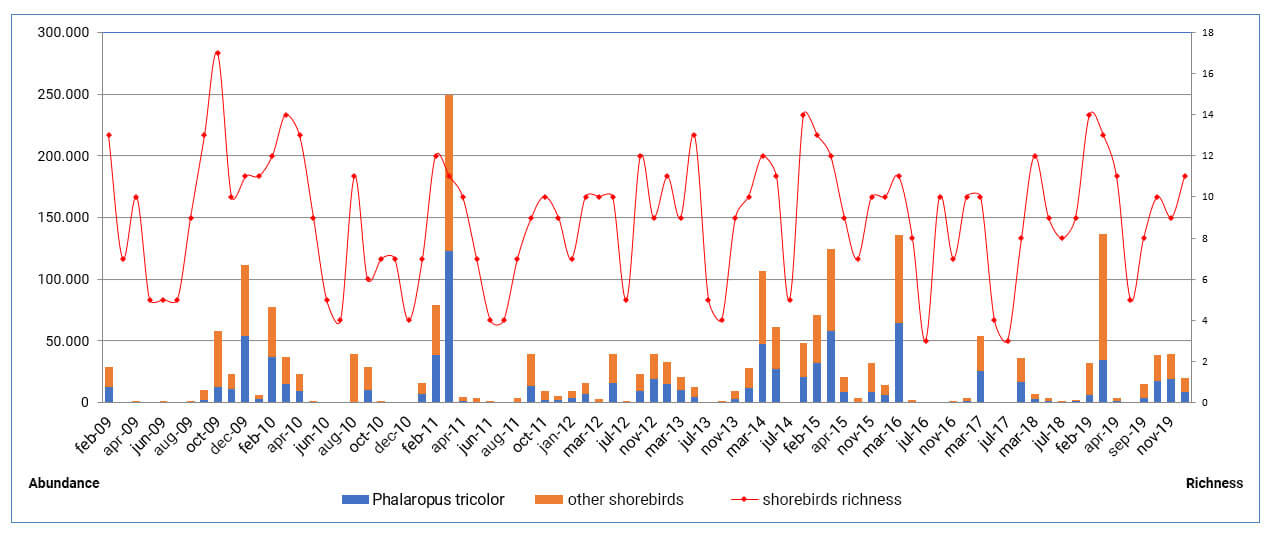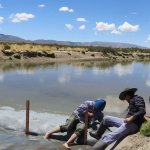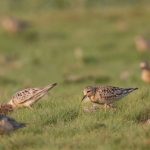By Ana Laura Sureda, Flavio Moschione, Leonidas Lizárraga y Carina Rodríguez – Administración de Parques Nacionales
Laguna de los Pozuelos is one of the most extensive wetlands in northwestern Argentina. It is a true oasis at an altitude of 3665 m in the Puna of Jujuy Province, and, upon its declaration in May 2014, was the first continental altiplano locality to be included in the Western Hemisphere Shorebird Reserve Network (WHSRN).
The floodplain of the lagoon fluctuates naturally from year to year, sometimes exceeding 30 km2. It has been designated a National Protected Area (Área Protegida Nacional), and is the nucleus of the eponymously named Biosphere Reserve (Reserva de Biosfera), which protects 3.800 km2 of the Pozuelos basin.
The abundant and characteristic communities of waterbirds that congregate at Pozuelos throughout the year are one of its most attractive and valuable conservation assets, and have been the focus of numerous surveys and studies since the region was designated as a Protected Area in 1980. Since 1996, the site has been included in the International Simultaneous Census of High-Andean Flamingos (Censo Simultáneo Internacional de Flamencos Altoandinos) that is periodically carried out by the Alto-Andean Flamingo Conservation Group (Grupo de Conservación de Flamencos Altoandinos or GCFA).
Since 2006, at least six censuses of waterbirds have been carried out annually: in summer (February), winter (July), spring (October and November) and fall (March and April); these last two seasons were key for the recording of migratory species at the site. The monitoring dates are coordinated with those of the Neotropical Waterbird Census, the International Simultaneous Census of High-Andean Flamingos (GCFA) (which also monitors the Vilama Lagoons in cooperation with Jujuy Ministry of the Environment), and most recently with the protocol of the International Shorebird Census (ISS). The spring and fall censuses also coincide with the dates of the Cornell Laboratory initiative, Global Big Day.
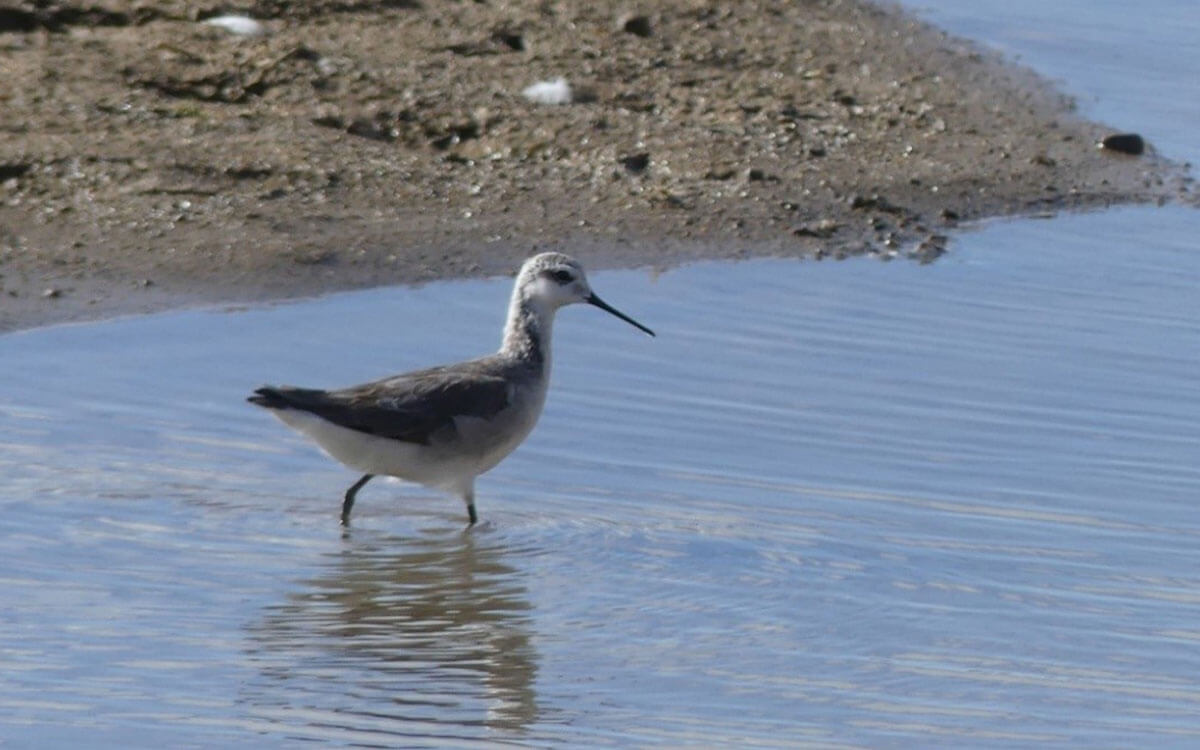
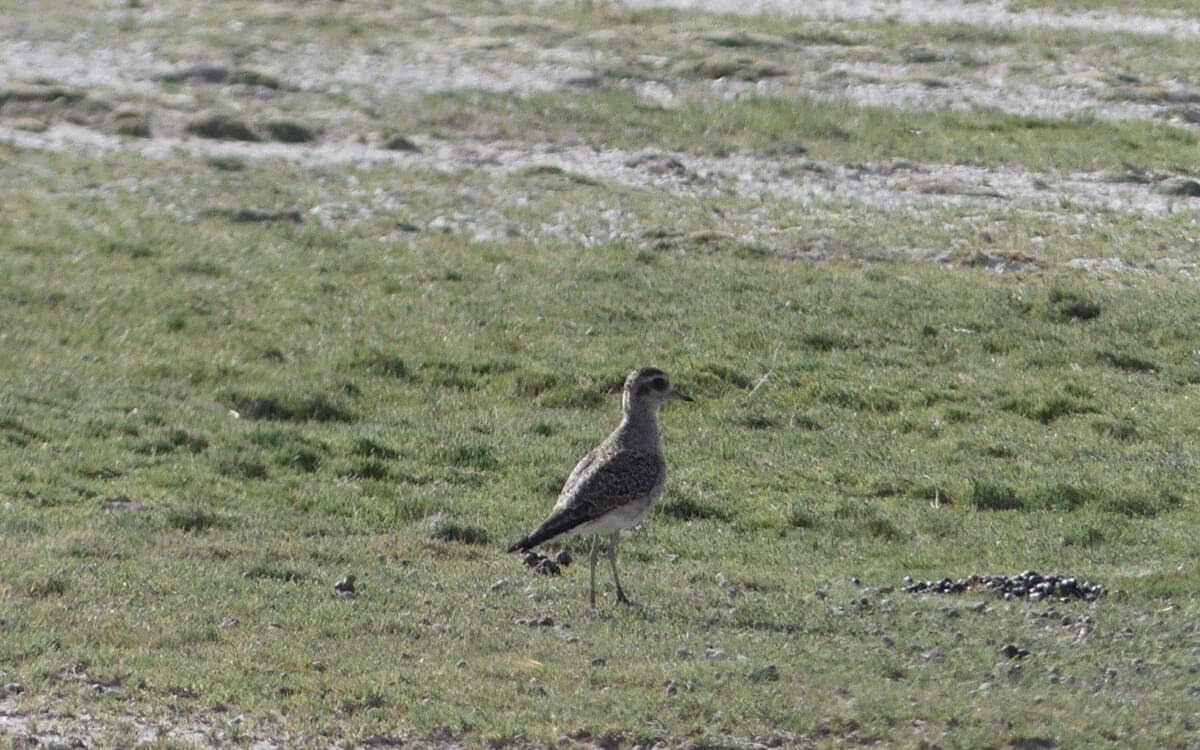
Left: Wilson’s Phalarope (Phalaropus tricolor) at Laguna de los Pozuelos. Right: American Golden Plover (Pluviallis dominica). Photos: Flavio Moschione.
Monitoring is carried out by qualified technicians and includes the participation of forest guards, agency staff, and volunteers. The results are made public through a web portal in the Biodiversity Information System of the National Protected Area (Sistema de Información de Biodiversidad de la APN): https://sib.gob.ar/novedades/monitoreo-de-aves-acuaticas-en-el-monumento-natural-laguna-de-los-pozuelos2
Such studies have recorded 30 species of shorebirds at the site, with three long distance migrants dominant in terms of abundance and presence, the Wilson’s Phalarope (Phalaropus tricolor) which can number as many as 123,000 individuals, Baird’s Sandpiper (Calidris bairdii) with as many as 36,350 individuals counted, and Stilt Sandpiper (C. himantopus) with counts of up to 9,900; as well as the resident Puna Plover (Charadrius alticola) which can reach 5,650 individuals.
Some species that are rarely in the rest of Argentina have also been recorded fairly regularly from Pozuelos, such as the Semipalmated Sandpiper (C. minutilla) and the Least Sandpiper (C. pusilla), which are species typically associated with the Pacific Migration Corridor, as is the case with the Sanderling (C. alba). Additionally, two species have been recorded that represent the sole records for Argentina: Wilson’s Plover (Ch. wilsonia) and Marbled Godwit (Limosa fedoa).
In February of this year, the summer monitoring was conducted simultaneously with the GCFA International Flamingo Census and the 2020 Phalarope Census, and work was completed just prior to the COVID-19 sanitary emergency. Laguna de los Pozuelos was unseasonally dry at this time, and the counts were considerably lower than usual: 8,545 Phalaropes and 11,400* individuals of 11 species of shorebirds in total. On the other hand, given that the motive for performing the census was to survey other important altiplano wetlands of northeastern Argentina, it was possible to find important concentrations at other sites in the Jujuy Puna: 6,772 Phalaropes at Laguna Guayatayoc (6,913* individuals of 4 species of shorebirds) and 143,649 in Laguna Palar, part of the Vilama complex (where 149,258* individuals of 11 species were reported when considering the entire Ramsar site), numbers that are infrequently recorded and strengthen the hypothesis that the High Andean sites function as a network of alternatives that respond to the habitual environmental and climatic variables of the Puna.
Fig. Abundance and richness of shorebirds monitored at the census stations at Laguna de Pozuelos (February 2009 to February 2020).
The area is not only important for shorebirds; it is also a crucial site for other waterbirds, many of these representing important populations of Puna endemics, such as the Horned Coot (Fulica cornuta). The surrounding area is also of great importance for the conservation of Vicuña (Vicugna vicugna) and Puna Rhea (Pterocnemia tarapacensis).
This periodic surveying and monitoring is key to the conservation of the site, and is an important tool for wildlife managers and other institutions that participate actively in research, monitoring and conservation projects, by allowing an effective and coordinated response to the diverse threats that the locality faces.
*The numbers include the phalaropes, which are the dominant species in the shorebird communities of the altiplano.
Cover Photo: James Flamingos (Phoenicoparrus jamesi), Phalaropes and Baird’s Sanpipers at Laguna de los Pozuelos. Photo: Flavio Moschione.




